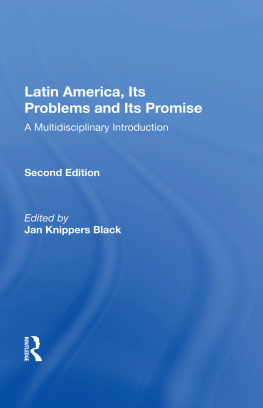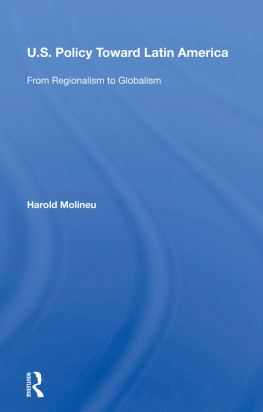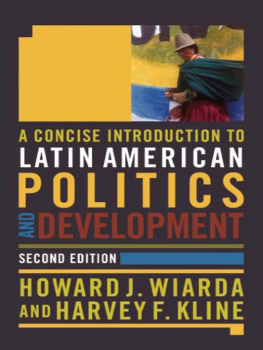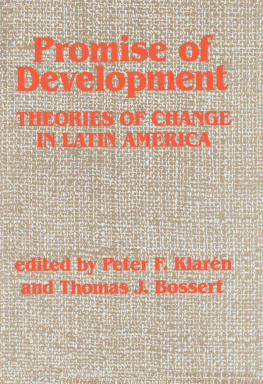First published 1991 by Westview Press
Published 2018 by Routledge
52 Vanderbilt Avenue, New York, NY 10017
2 Park Square, Milton Park, Abingdon, Oxon OX14 4RN
Routledge is an imprint of the Taylor & Francis Group, an informa business
Copyright 1991 by Taylor & Francis
All rights reserved. No part of this book may be reprinted or reproduced or utilised in any form or by any electronic, mechanical, or other means, now known or hereafter invented, including photocopying and recording, or in any information storage or retrieval system, without permission in writing from the publishers.
Notice:
Product or corporate names may be trademarks or registered trademarks, and are used only for identification and explanation without intent to infringe.
Library of Congress Cataloging-in-Publication Data
Latin America, its problems and its promise : a multidisciplinary
introduction / edited by Jan Knippers Black. 2. ed.
p. cm.
Includes bibliographical references and index.
ISBN 0-8133-0904-2 (hardcover). ISBN 0-8133-0905-0 (paperback)
1. Latin America. I. Black, Jan Knippers, 1940
F1406.7.L38 1991
980dc20
90-44422
CIP
ISBN 13: 978-0-367-00352-4 (hbk)
Contents
, Jan Knippers Black
PART ONE
THE LAND AND THE PEOPLE
, Alfonso Gonzalez
, Karl H. Schwerin
PART TWO
HISTORICAL SETTING
, Peter Bakewell
, E. Bradford Burns
PART THREE
CULTURAL EXPRESSION
, Fred Gillette Sturm
, Tamara Holzapfel
, Mary Grizzard
PART FOUR
ECONOMIC AND SOCIAL STRUCTURES
, William P. Glade
, Gilbert W. Merkx
PART FIVE
POLITICAL PROCESSES AND TRENDS
, Jan Knippers Black
, Jorge Nef
PART SIX
EXTERNAL RELATIONS
, James Lee Ray
, Jerome Slater and Jan Knippers Black
, Larman C. Wilson
PART SEVEN
MEXICO
, Fred R. Harris
, Martin C. Needler
PART EIGHT
CENTRAL AMERICA AND PANAMA
, Richard Millett
, Eldon Kenworthy
, Steve C. Ropp
PART NINE
CUBA AND THE CARIBBEAN
, Nelson P. Valds
, Anthony P. Maingot
PART TEN
THE ANDES
, John D. Martz
, Jos Z. Garca
PART ELEVEN
THE SOUTHERN CONE
, J. Samuel Valenzuela and Arturo Valenzuela
, Peter G. Snow
, Diego Abente
PART TWELVE
BRAZIL
, Michael L. Conniff
, Brady Tyson
, Jan Knippers Black
1
Introduction: Approaches to the Study of Latin America
JAN KNIPPERS BLACK
To the student who must launch his or her exploration of Latin America through the eyes and ears, the assumptions and perspectives, and the theoretical and ideological filters of others, it would be useful to know something of the intellectual paths that have been traveled by the specialists in the field. Those paths have circled, dead-ended, and U-turned, merged and diverged; they are now, as always, subject to turns in new directions. The attempt to understand social relations, especially in an area so diverse and complex as Latin America, can never be a simple matter of learning the facts. There will always be many facts in dispute; answers depend on the nature of available data, on the interests of the sources consulted, and on how questions are asked. Confronted, as one must be in a multi-authored text, with differing points of view and, thus, differing interpretations of the same historical and social data, the student may find it worthwhile to begin the study of Latin America with a study of Latin Americanists.
It is to be expected that interests and interpretations of social phenomena will vary from one discipline to another. The geographer may find, for example, that soil quality, climate, and topography determine settlement patterns and socioeconomic relations, which in turn configure political systems. The anthropologist may find explanation for social harmony or social conflict in ethnic and cultural patterns. The economist may find that political trends derive from economic ones, while the political scientist may see power relationships as overriding. In the study of Latin America, however, there has always been a unifying theme.
From the perspectives of U.S.- and European-based scholars, as well as from those of Latin American own creative and scholarly writers, the study of Latin America has been approached as the study of a problem, or set of problems. The problems might be capsulized as underdevelopment and political instability or, more simply, as poverty or inequality and the failure of democratic systems to take hold. The search for the roots, causes, and progenitors of these problems has generally led in one of three directions: to the Iberiansthe conquistadores and the institutions, attitudes, and cultural traits they brought with them to the New World; to the Latin Americans themselvesthe alleged greed of the elites, absence of entrepreneurship in the middle classes, or passivity of the masses; or to the United States and the international capitalist system it promotes and defends.
Long before U.S. scholars began to direct their attention to Latin Americas problems, the areas own intellectuals were absorbed by the question of where to place the blame. Domingo Faustino Sarmiento and other nineteenth-century intellectual and political leaders of cosmopolitan Buenos Aires blamed the cycles of anarchy and tyranny their newly independent country was suffering on Hispanic influences. Sarmiento in later life directed his scorn toward Latin Americas own melting pot. Influenced by social Darwinism, he diagnosed the decadent state of Argentine society as deriving from its racial components of Spanish, mestizo, Indian, and Negro.
Turning the tables at the turn of the twentieth century, Jose Enrique Rodo, Uruguays foremost literary figure, urged the youth of his countryin his masterpiece, Ariel to shun the materialism of the United States and to cling to the spiritual and intellectual values of their Spanish heritage. A strong current of Latin American social thought, reflected in art and music as well as literature, that gained momentum a few decades into the twentieth century has touted the strengths of native American cultures and blamed both Hispanic and North American influences for the prevailing instability and social injustice. Likewise, in the Caribbean, the Black Power movements of the sixties and seventies called Europe and Anglo-America to task for the regions underdevelopment.











